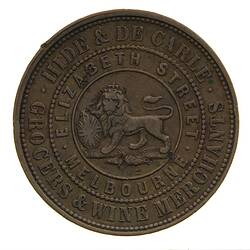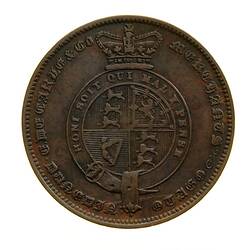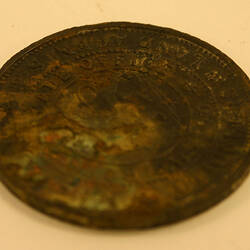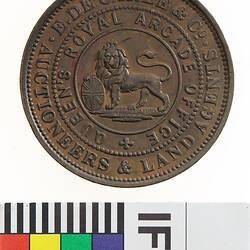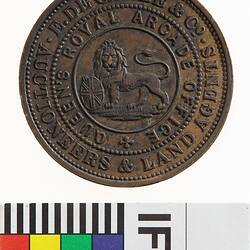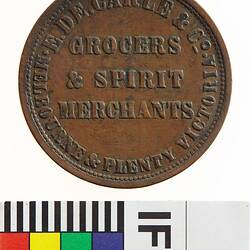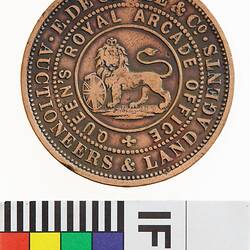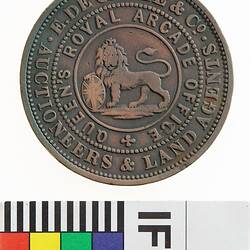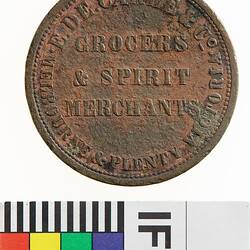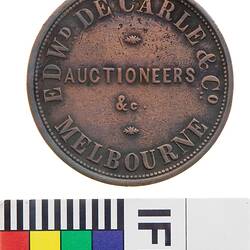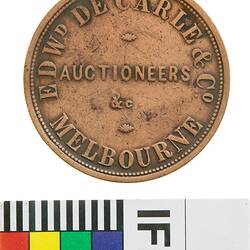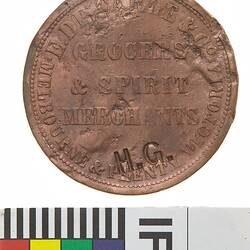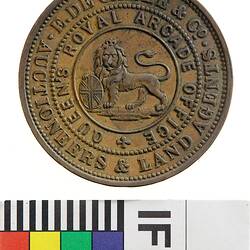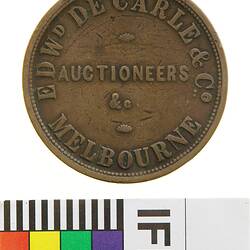Gardner says that, 'Mr. E. (Edward) de Carle, the founder of this firm, was a stout, thickset man,' who arrived in Australia in 1849. Over the following fourteen years he was involved in a wide range of business ventures in Melbourne, taking advantage of the explosive growth caused by the gold rush. He later moved to New Zealand, where he died.
A genealogical enquiry file at the State Library of Victoria (SLV) presents the following business chronology:
1851: De Carle, Henry and Edward, Stationers and Ironmongers
1853: De Carle and Holme, wine and spirit merchants, 28 & 30 Lt. Bourke Street East
1854 & 1855: De Carle, E., Arcade Office, 12-13 Queen's Arcade
1856: De Carle and Holme, Auctioneers 28A Little Bourke Street East
1858: De Carle, E., of Hide and De Carle, Merchants, 28 Little Bourke Street East
1859: De Carle, Edward, p.r. [private residence] Sandhurst St. North Melbourne
1863: De Carle, E., Albion Street East, Brunswick
1873: First entry in directory for De Carle Street, Brunswick, near his previous address on Albion Street.
In his three different tokens, which featured his business as 'Grocers and Spirit Merchants,' 'Auctioneers and Land Agents' and as 'Auctioneers, etc.,' de Carle clearly indicated the range of his business activities and speculation. At an early stage, De Carle was involved in the urbanisation of Footscray and a section of Brunswick. To quote Gardner:
'In the early days of Victoria he had a large place out at Brunswick in a kind of suburb known as 'Lyndhurst,' extending from close to the termination of Lygon Street, Carlton, in the south to Albion Street in the north, and from the Merrie Creek nearly to the Sydney Road, and which was then a very fashionable quarter. His memory will last for many years in that locality, for running parallel to Sydney Road is De Carle Street, evidently named after him. He also bought a large tract of land where Footscray now is, and cut it up into allotments in 1853. This really was the origin of Footscray.'
De Carle operated his businesses with a number of partners, in a network of business dealings. According to Gardner, de Carle was the leading partner in the Queen's Arcade, and his partners were 'Messrs. Luscome, Lee and Holmes.' Holmes was, as the SLV file shows, De Carle's business partner in other ventures in 1853 and 1856.
The Queens Arcade was the first to be built in Melbourne. Among the tenants there the Levy Brothers and S & S Lazarus, both token issuing businesses (see their respective parties records for further details). The opening of the Queen's Arcade was described in Wm. Kelly's Victorian Life vol.1, pp.307-310:
'A few days after the mayor's ball (held in October 1853 by Mayor T.J. Smith) there was another grand at a new establishment, the "Queen's Arcade," given in celebration of its opening, at which the governor was present, and a great but mixed crowd, the majority of whom were townsfolk. The Queen's Arcade itself was a bold, and, I regret to say, rather an unsuccessful speculation - unsuccessful principally, from the constraint of position, being too far removed from those haunts and avenues where the bulk of population love to congregate. Nothing could have been more agreeably comfortable to such a climate as that of Victoria, or to a city subject to such visitations as Melbourne, wanting as it was in all those out-door arrangements that tend to counteract the disagreeabilities of dust and mud. Had they augmented the amount (of money spent constructing the arcade) to a figure enabling them to purchase property for its site running out of Great into Little Bourke-street, I am perfectly assured it would have been a "decided hit" but its unapproachable remoteness almost suddenly collapsed it after a start of unprecedented promise.
The Queen's Arcade runs from Great Lonsdale-street into Little Bourke-street, covering longitudinally a space of three hundred and sixty feet by a breadth of thirty-three feet. The central footway, which is boarded, occupies about one-third of the area, the other two-thirds being equally allotted to two ranges of neat little shops on either side. The roof is a rounded one, the light being admitted by a range of several windows between the eave and the roof of the shops. The principal front is in Great Lonsdale-street, where two handsome two-storey shops, connected by a fine archway denote the entrance. The windows render it sufficient illumination in the daytime, and a row of splendid chandeliers illuminate it in the evening. There was an immense run for shops at its first opening and the novelty of the thing attracted the multitude.'
Kelly goes on to state that the arcade declined in popularity largely because, being located in Lonsdale Street, it was too far from the main activities of the city for people to go and 'see and be seen' while shopping. He also partly lays the blame on the Lazarus and the Levy Brothers (see their parties records for Kelly's treatment of these Jewish-owned, enduring businesses). The Queen's Arcade survived for at least nine years. In the 1858 Sands and Kenny Directory of Melbourne, an advertisement for the arcade begged 'to call attention to this elegant avenue as a lounge, as well as a place for the purchase of articles for the boudoir and the drawing room table.' The advertisement then went on to describe the range of goods available, and the relative luxury and expense of its construction. In 1862, an advertisement in the Sands and McDougall directory called attention to J.B. Coleman's Queen's Arcade Restaurant 'now universally admitted to be the largest and cheapest board and lodging establishment in the Australian Colonies.'
De Carle was also in partnership with Robert Hide between 1858 and 1861 in the firm Hide and De Carle. For more details about this partnership see the record for 'Hide and De Carle'. After the conclusion of this partnership De Carle moved to Dunedin, where he later died.
Edward De Carle issued tokens five times, one circa 1853 and the others circa 1855. The 1853 tokens were struck by Pope & Co. in London, the 1855 by Heaton and Sons of Birmingham.
References:
Gardner, F. (1910). 'Trade Tokens and the Firms who Issued Them', Australian Storekeepers and Traders Journal, 31 May, p.10.
State Library of Victoria Genealogical Enquiry file, E. De Carle.
Melbourne Commercial Directory, 1854.
Melbourne Commercial Directory 1855 compiled by J. Butterfield.
Commercial, Professional and Legal Directory for 1856.
Sands and Kenny Melbourne Directory, 1857.
Tanners Melbourne Directory for 1859.
Sharples, J. (1993). 'Catalogue of Victorian Trade Tokens' in Journal of the Numismatic Association of Australia, Vol. 7, pp.32-34.
Advertisement, Sands and Kenny's Commercial and General Melbourne Directory for 1858, unnumbered page.
Sands and McDougall's Commercial and General Melbourne Directory for 1862, advertisements p.33.
More Information
-
Keywords
-
Localities
-
Authors
-
Article types

